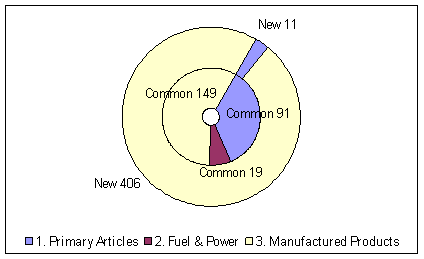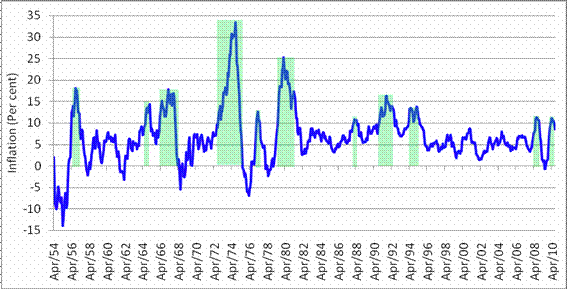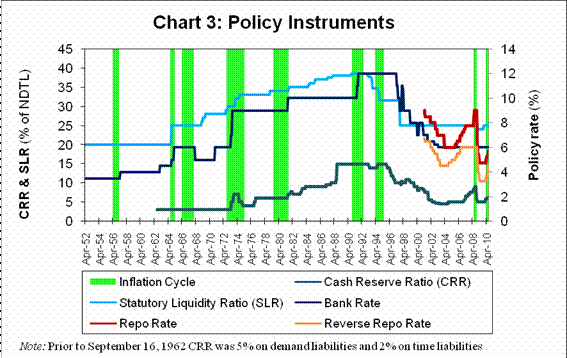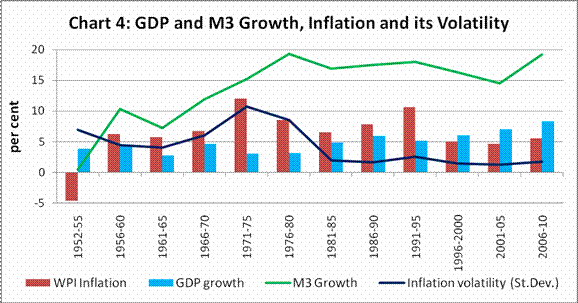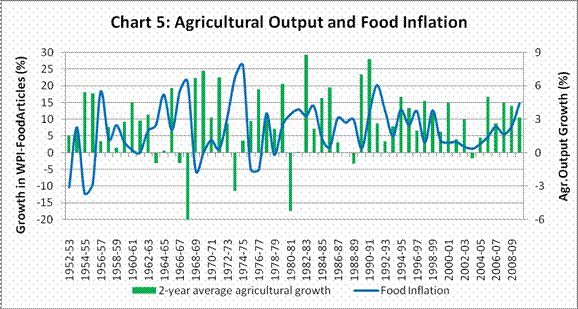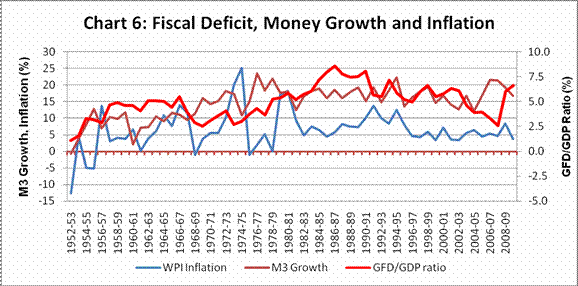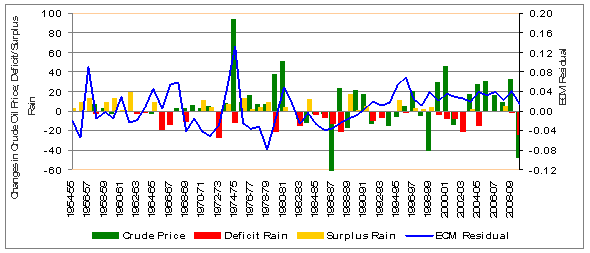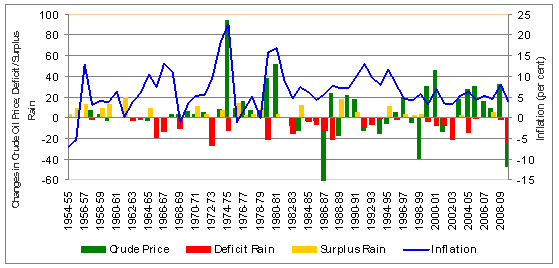 IST,
IST,


Perspectives on Inflation in India
Shri Deepak Mohanty, Executive Director, Reserve Bank of India
delivered-on ऑक्टो 01, 2010
I thank the Bankers Club, Chennai and Shri T.M.Bhasin, Chairman & Managing Director, Indian Bank for providing me this opportunity to speak before you. As you know, the Reserve Bank released its first Mid-Quarter Review of Monetary Policy for 2010-11 on September 16, 2010 raising policy interest rates for the fifth time since March 2010. The Reserve Bank is concerned over the unacceptably high inflation rate. In the meanwhile, the Government has also released the new series on the Wholesale Price Index (WPI) changing the base year from 1993-94 to 2004-05. Against this background, I propose to speak on inflation. I will focus on three issues. First, I will place before you some salient features of the new series of WPI. Second, I will give a snapshot of our history of inflation from 1952-53. Third, I will give a brief analysis of the determinants of inflation. I will conclude with some observations on the nature of monetary policy response in the past and in the current phase of inflation. 1. New Series on WPI Inflation As you know, the Reserve Bank looks at various indices and indicators of inflation. WPI inflation is taken as the headline inflation in India. The Reserve Bank’s policy articulation and inflation projection are in terms of WPI. Hence the new series on WPI is of particular importance. Considering the data for the past five years, 2005-06 to 2009-10, it is seen that there is not much difference in average inflation rate between the new series and the old series which is about 5.5 per cent (Table 1).
This similarity, however, masks a number of significant changes in the new series. First, the basic feature of any price index updation is to adequately capture the current structure of the economy, consistent with the consumption pattern and the price trends at a disaggregate level. In terms of change in the relative weight of major commodity groups, the share of primary articles has gone down by 1.9 percentage points, which has been compensated by increase in the share of fuel group by about 0.7 percentage point and manufactured products by 1.2 percentage points. There has been a reduction in weightage of primary food articles and manufactured food products by 2.6 percentage points in the new series to 24.3 per cent from about 26.9 per cent in the old series. Second, notwithstanding a significant reduction in weightage, the food inflation in the new series is higher than in the old series. This is because of change in the consumption basket in favour of protein-rich items such as egg, meat and fish where price rise has been high apart from milk and pulses. Third, the non-food manufactured products inflation is lower in the new series than in the old series. This is because of a substantial overhauling of the basket with the introduction of a number of new items. For example, the new series has 417 new commodities of which 406 are new manufactured products (Chart 1). Fourth, the new series has wider coverage. For example, the number of price quotation has increased from 1918 in the old series to 5482 in the new series. The new series, therefore, is better representative of overall commodity price inflation.
II. Long-term Inflation Trend The WPI series is available from the year 1952-53 onwards though the base year has undergone revisions from time to time. The monthly year-on-year inflation for the 56 years from 1953-54 to 2009-10 is plotted in Chart 2. A visual impression of Chart 2 suggests the following. First, inflation was quite volatile in the initial three decades of the 1950s, 1960s and 1970s. But the volatility has reduced in the subsequent decades even with occasional spikes in inflation. Second, since the high inflationary phase of the mid-1990s, the inflation rate has moderated. It has remarkable stability coinciding with great moderation globally except for the recent two brief episodes of double digit inflation each persisting about 5 months in June-October 2008 and then during March-June 2010.
Going by the current experience of 5-6 months of double digit inflation as high, one can trace 9 such episodes in the last 56 years. Out of these 9 episodes, double digit inflation lasting beyond a year occurred on 5 occasions. The most prolonged one lasted for 30 months during October 1972 to March 1975. The last such high inflation was in the mid-1990s which lasted 15 months between March 1994 and May 1995. The Reserve Bank responded to the phases of high inflation through available policy instruments (Table 2 and Chart 3).
Notwithstanding these episodes of double digit inflation, it is important to recognize that India has been a moderate inflation country and the average inflation has come down over the last 15 years. For the 56 years period from 1953-54 to 2009-10, the monthly annual average inflation is around 6.7 per cent. There has particularly been a perceptible drop in the average WPI inflation to about 5.1 per cent in the last decade during 2001-02 to 2009-10. III. Determinants of Inflation There are factors, both from the supply side and the demand side, which explain the behavior of inflation. But a common thread runs through the periods of high inflation. These typically include any one or combination of the following: (i) war, (ii) drought, and (iii) commodity price shocks, particularly oil prices. Supply shocks accompanied by demand pressures such as high fiscal deficit reflected in high money supply growth further accentuated inflationary pressures. In a long-term framework, the inflation rate can be hypothesized to evolve around a trend. The underlying trend can be considered as the core which is largely influenced by demand conditions. However, for developing countries like India, medium-term supply response corresponding to the changes in demand conditions is important to the determination of the trend. For example, in our case we have seen a sharp reduction in trend inflation during the 2000s on improved supply response following wide-ranging economic reforms and liberalization initiated in the 1990s in the real and financial sectors. Emphasis on fiscal consolidation, discontinuation of the practice of automatic monetization of fiscal deficit, market determined exchange rate system and greater reliance on price signals vastly improved the underlying macroeconomic framework. These had a positive impact on our macroeconomic preferences, including a clear drop in the long-term inflation trend and a decline in the volatility of inflation with a step-up in economic growth (Chart 4). The fluctuations around the trend are determined more by the severity of supply shocks and the nature of policy responses. One of the recurrent supply shocks influencing inflation conditions in India emanates from the agricultural sector due to drought conditions (Chart 5). Food inflation, which has always been a major source of fluctuation in the headline inflation, has a significant negative correlation (-) 0.5 with 2-year average growth in agricultural GDP.
If the supply shock is prolonged and monetary policy remains accommodative for an extended time period, supply induced inflation tends to get generalised. This is a lesson learnt in macroeconomics following the oil price shock of the early 1970s which triggered a world-wide inflation. Hence, policy authorities were wiser in handling subsequent supply shocks by not extending policy accommodation beyond a point. Fiscal deficit was a major factor in the determination of inflation in the 1980s. With fiscal consolidation after the mid-1990s, monetary growth became more commensurate with the overall economic growth contributing to reduction in inflation (Chart 6).
Against this background, let me now turn to a simple but more formal assessment of the determinants of long-term inflation which can be considered as output and money supply. Since agricultural GDP is frequently interrupted by weather conditions, non-agricultural GDP and money supply can be considered as the more relevant variables in the determination of the inflation trend. Empirical exercise based on annual data for the 57 year period, 1952-53 to 2009-10, shows that there is a co-integrating long-term equilibrium relationship among inflation, non-agricultural GDP and money supply.2 From this exercise, the following inference can be drawn. First, non-agricultural GDP has a highly significant and negative relationship with inflation, which implies that an increase in non-agricultural GDP representing improved supply condition will decrease inflation. Second, money supply has a highly significant and positive relationship with inflation. One per cent increase in money supply in absence of any increase in non-agricultural GDP could lead to 0.9 per cent increase in inflation. Third, alongside increase in money supply by one percent, if non-agricultural GDP also increases by one per cent it will have a dampening effect on inflation. But still inflation could go up by 0.15 per cent in the long-run. Fourth, deviation from the long-run equilibrium is statistically significant and the adjustment towards the long-run equilibrium is faster through changes in the non-agricultural GDP.3 Fifth, there is a two way causal relationship between money supply and prices.4 Notwithstanding this relationship, inflation has strayed from its long-term path from time to time. The upward spikes in inflation from its trend are explained by significant supply shocks. Generally, high inflation periods were coincident with episodes of oil price surge and drought conditions. This can be seen from the plot of residual from the long-term equation (Chart 7).
This pattern is more pronounced when plotted against the actual inflation rates (Chart 8)
IV. Conclusions The above discussion leads to the following major conclusions. First, the new series of WPI inflation marks a major change in terms of scope and coverage of commodities and is more representative of the underlying economic structure. As per the new series, the manufactured products inflation is lower than what was seen on the basis of the old series. The food price inflation, on the other hand, is higher than what was seen on the basis of the old series. The high level of food prices is indeed a matter of concern as the prices of protein-based items, which have a higher share in the consumption basket, are showing larger increases. Moreover, there is continuing shortage of food items such as pulses and edible oils. If the supply response doesn’t improve, there is a risk that food price inflation could acquire a structural character. Second, historical data show that India is a moderate inflation country. But there have been phases of sharp spikes in inflation emanating from war, drought and commodity price shocks. Supply shocks when accompanied by demand pressures further amplified inflationary pressures. But the inflation rate has reverted to its trend following policy response and improved supply conditions. In the periods of high inflation, monetary policy responded with a combination of available policy instruments through changes in policy interest rates, cash reserve ratio (CRR), statutory liquidity ratio (SLR), and in the earlier regime through increased in administered interest rates and credit control. Third, the volatility as well as incidence and duration of double digit inflation has reduced over time. Inflation control since the mid-1990s has been particularly successful which can be attributed to wide ranging reforms which have improved the macro-policy framework and eased supply constraints. Fourth, the long-run inflation trend is determined by non-agricultural GDP and money supply. Increase in money supply unaccompanied by a commensurate increase in non-agricultural GDP is potentially inflationary. Finally, with the reduction in average inflation and inflation volatility, since the mid-1990s, tolerance for high inflation has come down. The moderation of inflation trend has had several beneficial effects in terms of lower nominal interest rate and high GDP growth rate. Given the remarkable stability in the inflation rate since the mid-1990s, it is important to persevere with appropriate policy responses so that the high inflation seen in the recent months does not get entrenched. Even if the trigger for inflation is from supply side, its persistence necessitates monetary policy responses to bring the inflation rate back to its trend and anchor inflationary expectations. 1 Speech by Deepak Mohanty, Executive Director, Reserve Bank of India, delivered at the Bankers Club, Chennai on September 28, 2010. The assistance provided by Dr.O.P.Mall, Dr.Abhiman Das and Shri Binod B. Bhoi is acknowledged. 2 In WPI = 6.15 - 0.75* In Non-Agri-GDP + 0.90* In M3. * Significant at 1% Corresponding error correction (EC) model including crude oil price and rainfall as exogenous variables is estimated as: WPI-inflation = -0.038*EC + 0.766*growth in money supply(-1) + 0.063*growth in crude oil price + 0.139* deficit in rainfall. * Significant at 10% 3 The error correction term is negative and the speed of adjustment coefficient for non-agricultural GDP is significant at 1% and that of WPI at 5% with negative signs. 4 This implies that in the short-run changes in price cause changes in money supply which, in turn, causes changes in prices. |
|||||||||||||||||||||||||||||||||||||||||||||||||||||||||||||||||||||||||||||||||||||||||||






